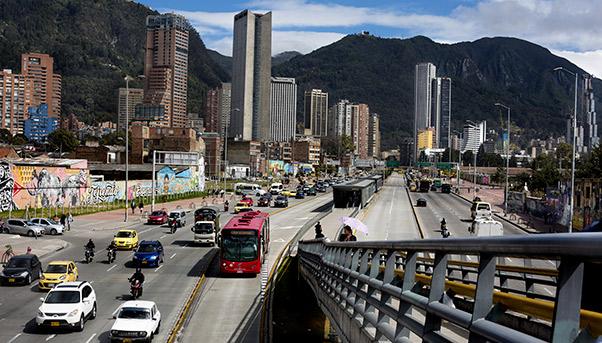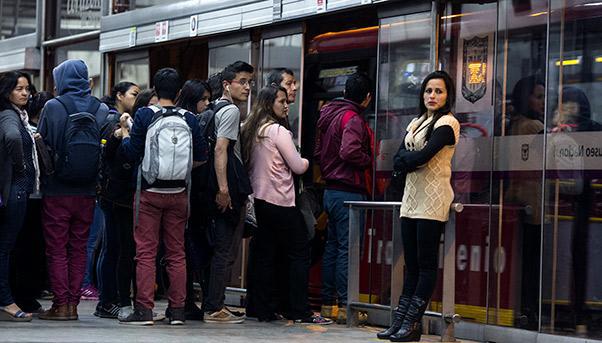
In uncongested cities, an ambulance siren sneaks up behind you, grows to a roar, and then fades away just as suddenly as it started. Not in Colombia’s capital. Here, sirens never seem to fade. That is because Bogotá’s packed roadways usually do not let ambulances – not to mention daily commuters – escape the thick traffic jams that have come to symbolize this city of nearly eight million residents.
Like many of Latin America’s cities, Colombia’s capital urbanized rapidly during the second half of the 20th century. Its population ballooned from around 120,000 residents in the early 1900s to 2.5 million by 1970, hitting seven million by 2000. Cities elsewhere in Latin American implemented mass urban transit systems, but Bogotá’s metro plan stayed on the drawing board. Today, the city seems to be at an inflection point. A new mayor, Enrique Peñalosa, promises to solve Bogotá’s mobility problem with a redesigned metro, more bike lanes, and a rethink of the city’s expansion as Bogotá sets to triple in built-structures during the next 40-50 years.
Transmilenio
By the late 1990s, Bogotá was in a transportation crisis. The lack of a coherent mass public transit system encouraged the use of the car, which started to plug up the city’s roadways. The outcome of this crisis was a Bus Rapid Transit System known as Transmilenio. The system, inaugurated in December 2000, gave passengers a faster alternative to a network of private bus companies and passenger vehicles. By 2000, Bogotá ran a fleet of diesel-powered buses through its 112-kilometres network consisting of 11 routes. Today, Transmilenio carries 2.0 million to 2.4 million passengers a day, covering around 30% of Bogotá’s transportation demand.
Although the system was a solution fit for the 1990s, the Transmilenio of today can no longer handle the greater commuter demand: residents complain of overcrowded stations, long waits and poor security. William Camargo, director of city hall’s Institute for Urban Development (IDU), says the commute for a resident of the Bosa neighborhood on the southwestern suburban rim to the central commercial district takes around one hour and 40 minutes one way.
The Future Metro
The metro design that is on the drawing board would start with a line of 27 kilometres with 27 stations connecting Bosa to the central government and business district of La Candelaria before running north to Calle 127. It would transport 45,000 people per hour in each direction when the line goes into operation in 2021. By 2050, Camargo expects the line to have capacity for 80,000 passengers per hour in each direction. The design involves 50 trains of six cars each that would run on an electric track. Stations would be connected to the public bus transport network (SITP) and there would be seven transfers with the Transmilenio.

Bogotà: A Transportation Revolution
The metro would have a significantly positive socio-economic impact on the city, says Camargo. Commute times from the southwest to the central district could get cut by half. “A person who goes from the southwestern part of the city to the center of the city can take one hour and 30 minutes to one hour and 40 minutes to get there under current conditions (usually with different modes of transport). To get from Bosa to Calle 127, it can easily take 2 hours. With the metro project, those times would get reduced to 45 minutes and the savings for a person working in that sector is very significant,” he says.
The IDU estimates 47 trillion pesos ($16 billion) in net savings measured in commute times, fuel cost, and the cost of the wear-and-tear on vehicles and roads.
“We have the project designed with the social, environmental and technical elements closed. Now we’re working with the National Development Fund (FDN) to structure the financial component,” says Camargo. The National Development Fund is presenting the project to international banks in the United States, the United Kingdom, China, South Korea and Brazil. The Latin American Development Bank (CAF) and World Bank have also expressed interest.
Camargo says the initial cost of the project will be on the order of 15 trillion pesos before rising to 20 trillion pesos when the 20-year period of financing finishes. Colombian President Juan Manuel Santos in May issued a symbolic 9.65-trillion-peso check to the city, a gesture of support for the metro plan. In October, the Colombian finance ministry’s fiscal policy council (CONPES) approved a financing scheme that pledges 70% of funding from national funds.
A gap still remains, but Secretary of Finance Ricardo Bonilla has insisted the project is financially viable.


